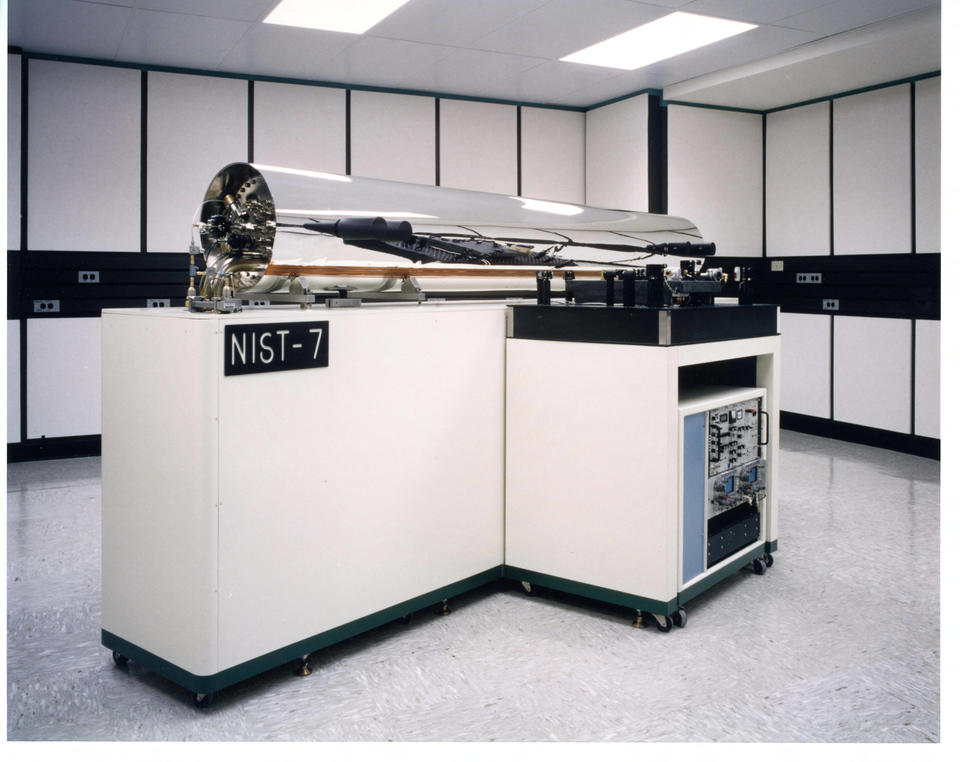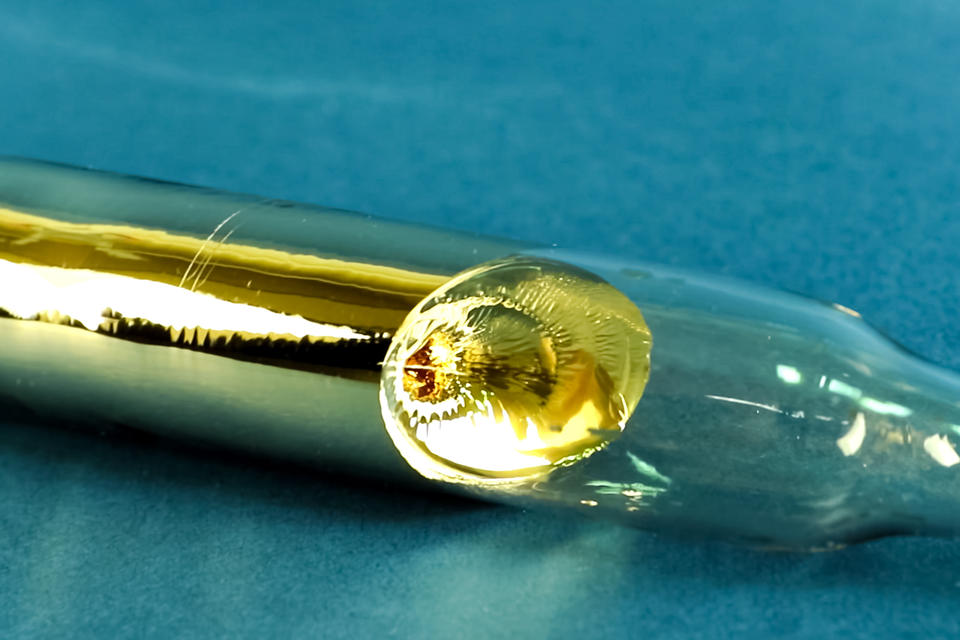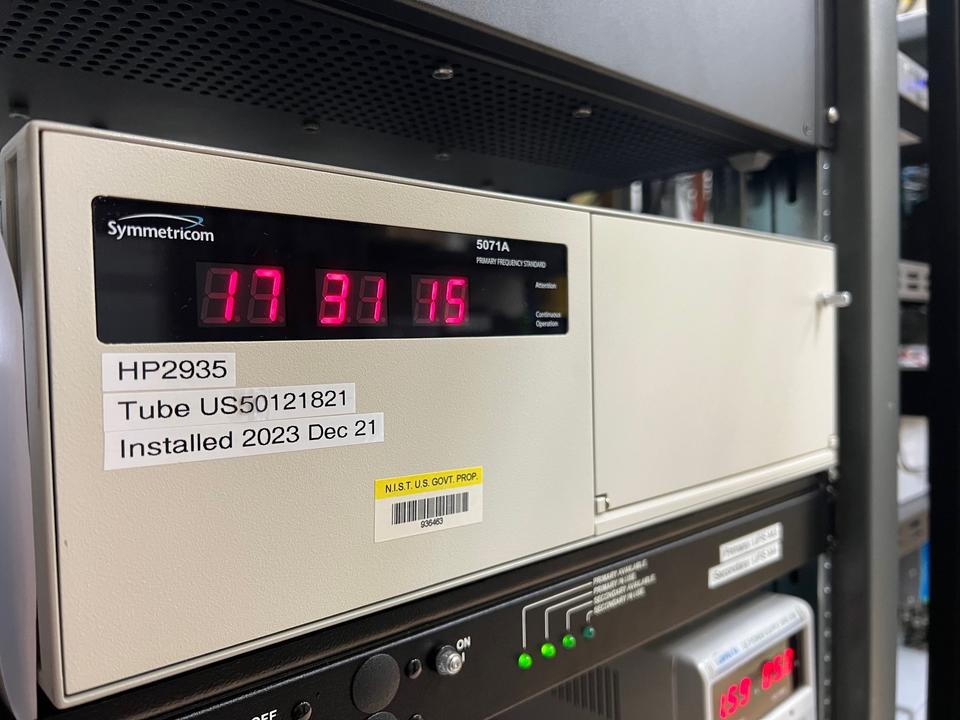Beams of Atoms: The First Atomic Clocks

Beam clocks are the workhorses of atomic time: reliable and steady. They got their name because they shoot beams of hot atoms down a long tube. Since the 1950s, beam clocks have ticked off the world’s seconds and given humanity an accurate and reliable foundation for global timekeeping.
Indeed, the first practical atomic clocks were beam clocks. They were based on cesium, a soft, gold-colored metal found in the leftmost column of the periodic table.

Like all atoms, cesium has a dense nucleus of particles called protons and neutrons, surrounded by a cloud of smaller particles called electrons. One electron wanders far from the rest, on the outskirts of the atom. We use this outermost electron to make a clock.
How do we do this? Quantum physics, whose laws govern tiny objects such as atoms, tells us that every electron is also a tiny magnet that can point in one of two directions. Depending on which direction the electron’s magnet is pointing, a cesium atom can have slightly more or less energy.
We can make the electron magnet flip by shining light of just the right color, or frequency, on the atom. This causes a quantum jump that sends it from the lower-energy state to the higher one. The special frequency that triggers this jump is called cesium’s resonant frequency. It’s within the range of light frequencies known as microwaves, which also include the ones you probably use to cook your food.

Here’s how a beam clock puts this idea into action: A gas of cesium atoms enters the tube and is briefly bathed in microwaves whose frequency is close to the cesium resonant frequency. The microwaves put the atoms into a special quantum state that combines the higher and lower energy states. This special state oscillates at exactly the cesium resonant frequency.
The atoms continue down the tube and are again immersed in microwaves. This time, the interaction between the microwaves and the atoms’ oscillating quantum state reveals how close the clock’s microwave frequency is to the cesium resonant frequency.
The closer the two frequencies are to each other, the more atoms end up in the higher energy state. A detector counts these atoms, and the counts are used to tune the microwave frequency to the atomic resonance.
The final step is to count 9,192,631,770 cycles of these finely tuned microwaves. The time it takes to count those cycles is equal to one second.
Where did the number 9,192,631,770 come from?
The number 9,192,631,770 to which the second is fixed is not a fundamental constant of nature. Rather, it emerged from a groundbreaking study done in the late 1950s. Astronomers at the U.S. Naval Observatory used exacting measurements of the Moon’s motion to divide a year into equal-length seconds. Physicists at the National Physical Laboratory in the U.K. then used a beam clock to count the cycles of microwave radiation tuned to cesium’s natural resonant frequency during one of those seconds. The revolutionary measurement, published in 1958, had an uncertainty of a few parts per billion — far less than the astronomical observations that at the time defined the second.
Atoms’ natural resonant frequencies, as far as we know, don’t change with time. The length of the year is also nearly constant. But Earth days are not. Since the 1958 measurement, Earth’s rotation has slowed, and the length of the day has increased. So the start of the day as defined by atomic time has drifted slightly away from true midnight as measured by the positions of the Sun, Moon and stars.
To keep astronomical time and atomic time synced, timekeepers have had to adjust the global time system known as Coordinated Universal Time on numerous occasions. Since 1972, this has been done by adding “leap seconds” to atomic time. Mysteriously, in the past few years, Earth’s rotation has started to speed up, and timekeepers may soon need to subtract a second — something that has never been done.
Some leading timekeepers have instead proposed to abandon leap seconds and, for the first time in history, divorce timekeeping entirely from the stars. How this problem will ultimately be resolved remains to be seen. One thing is for sure: The atomic clock is taking us to realms we’ve never explored.
Beam clocks revolutionized timekeeping by ticking off seconds that stayed pure and constant even as the wobbly Earth’s spinning rate ebbed and flowed. A few years after the beam clock was invented in 1955, nations around the world began using them as time standards.
And in 1967, recognizing the superiority of atomic time produced by beam clocks, the world’s timekeepers redefined the official international second based on the resonant frequency of the isotope, or variant, of cesium known as cesium-133. Read more about the SI second.
What is an isotope, and what does it have to do with timekeeping?
The number of neutrons in the nucleus can slightly change the atomic resonant frequency, and thus the ticking rate of a clock based on that atom. So it’s important to specify not only which element one is using for timekeeping, but which isotope of that element. Only one cesium isotope — cesium-133 — is used in atomic clocks.

An Industry Is Born
Beam clocks didn’t just revolutionize timekeeping; they launched an industry. The first commercial atomic clock, the “Atomichron,” came out in 1956 and sold for $50,000 — more than $500,000 today. A few years later, Hewlett-Packard developed a more compact cesium beam clock that proved far more successful. A version of this clock remains in production today and is used by national measurement labs around the world, including NIST, to produce accurate time.

Beam clocks also helped early GPS satellites keep time, though they have since been replaced by cheaper and smaller alternatives. Industries that need precise timing, including stock exchanges, telecommunications networks and internet data centers, often rely on commercial atomic beam clocks.
As good as they are, beam clocks also have weaknesses. Their hot atoms zip through the beam at hundreds of meters per second (up to more than 1,000 miles per hour). That gives the clocks only a very short time to probe the atomic resonant frequency, limiting their accuracy.
A second problem: As atoms dash down beam clocks’ tubes, their resonant frequencies can shift due to the Doppler effect. You’ve probably observed the Doppler effect when an ambulance or fire engine passed you with its siren blaring. As the siren passed, you might have noticed its pitch dropping dramatically. When the siren was approaching you, its sound waves were compressed, raising the apparent frequency and thus the pitch; as the siren began receding, the sound waves instead became stretched, lowering the pitch. A similar thing happens when an atom or light source moves relative to an observer or detector.
When the frequency of a fast-moving atom Doppler shifts, it becomes harder to measure precisely. These frequency shifts limit even the best beam clocks’ accuracies.
A third disadvantage of beam clocks is that to date, they have been too big and power-hungry to carry around. A typical unit is the size of a briefcase and draws around 50 watts of power, compared to around a third of a watt, or 300 milliwatts, needed to run a smartphone.
In 2023, however, NIST researchers unveiled a prototype compact atomic beam clock the size of a postage stamp. The team ultimately hopes to build a beam clock that consumes only around 150 milliwatts of power.
If the stability of these miniature clocks can be improved so they don’t drift over time, they could help people navigate where GPS is jammed or unavailable, such as underwater and in space. Someday we may even have beams of atoms keeping time in our pockets!

